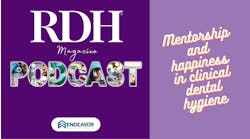The tornado that ripped through the farm hurled you so far from home that there’s no going back. Dorothy, you’re not in Kansas anymore. COVID-19 opened the door to a technicolored world of medical research. The spotlight on the oro- and nasopharyngeal airways as points of entry permanently cemented the link between oral and systemic. Dentistry is now somewhere over the rainbow.
Oral-systemic CEs during our time at home were more than just lifelines. They became our quintessence. It was a time for me to put the loupes down, push the stool back, and start owning my part in overall wellness.
Fired up and back at the office, I ran full speed into a wall of illness. The schedule morphed into a column of systemic diseases: Mrs. Rheumatoid at 8:00, Mr. Cardiac at 9:00, Mr. Diabetes at 10:00, and so on. I had naively picked up the oral-systemic baton but didn’t know where to run. How would I make a difference knowing that Porphyromonas gingivalis couldn’t be scaled from a carotid artery? Where was the road to the answers?
This tiny gas called nitric oxide (NO) is the "wizard" putting on the greatest show in mammalian physiology. Once produced, it acts as a signaling molecule diffusing across membranes and targeting virtually every organ in the body.1 Vasoregulation, nerve transmission, pain signaling, immune defense, metabolism, mitochondrial function, etc.2 NO is generated from two pathways. The first is endogenous. The second is dependent upon the oral microbiome.
You may also be interested in ... Nitric oxide: An essential product of the oral microbiome
L-arginine–NO pathway
This pathway involves the conversion of L-arginine amino acids into NO by enzymes called nitric oxide synthases (NOS).2 Its production is dependent upon a specific set of cofactors and conditions. Diseases characterized by oxidative stress, low levels of oxygen, or the uncoupling of NOS can shut down this process.1 The scenario leaves us with voids in neuronal communication, vessel dilation, and a functioning immune system. “Clinical studies provide evidence that insufficient NO production is associated with all major cardiovascular risk factors, such as hyperlipidemia, diabetes, hypertension, smoking, and severity of atherosclerosis, and also has a profound predictive value for disease progression including cardiovascular (CVD) and Alzheimer’s disease.”3
The three most common NOS are neuronal (nNOS), inducible (iNOS), and endothelial (eNOS).4 Because their activities overlap in many of the same cell types and organs, you may see the updated nomenclature as NOS I, NOS II, and NOS III respectively.2,3
NOS I, II, and III
NOS I participates in the central (CNS) and peripheral nervous systems (PNS).2 Although present in some cerebral vessels and glial cells, most of the NOS I activity is produced by neurons in the brain.5 In the CNS, it drives brain development, neural signaling, neurotoxicity, and the regulation of synaptic plasticity.5 Synaptic plasticity gives the brain the ability to learn, form memory, and modulate the expression of pain.5,6 NOS coordinates cerebral blood flow, which is critical for neurons and important for glial cells whose job it is to remove waste.7,8 In the mitochondria, it affects metabolism and muscle contraction by regulating oxygen consumption and energy production.5 Last, in the PNS, it regulates smooth muscle in the gastrointestinal, respiratory, vascular, and urogenital systems.5
NOS II was first identified in macrophages and neutrophils.2 Exposure to bacterial endotoxins or pro-inflammatory cytokines triggers the release of NO from activated immune cells to help fight off infection.1 This channel requires several hours and, once induced, can generate a large and unregulated concentration of NO.1 If left unchecked, excessive NOS II activation can “result in host tissue damage and is known to be an important aggravating factor in the etiology of periodontitis and other chronic inflammatory conditions such as cardiovascular disease.”6
The greatest amount of NOS III is released from the inner lining of our vessels.1 NO is essential for maintaining normal blood pressure, preventing adhesion of blood cells to the endothelium, and preventing platelet aggregation. 3 For instance, hypertension, particularly in high-risk patients, is a result of loss of balance and an absence of the ability to vasodilate normally.1 When blood flow is restricted, the shear force moving over endothelial cells triggers NOS III to release NO and activate vasodilation.6
NOS is also stimulated with platelet aggregation, potentially limiting platelet thrombus formation.1 “It may, therefore, be argued that this single abnormality, the inability to generate NO, puts us at risk for diseases that plague us later in life, such as hypertension, atherosclerosis, peripheral artery disease, heart failure, and thrombosis leading to heart attack and stroke, the leading cause of death for all Americans.”3
Nitrate–nitrite–NO pathway
Just as soon as we need the protective benefits of NO as we age, endogenous production declines.3 Fortunately, our bodies have a backup plan. Data supports the notion that nitrite can produce NO for the entire body and in far greater amounts.3 Unlike the L-arginine–NO pathway, it can be enhanced during hypoxia and low pH situations when nitric oxide generation by NOS may be compromised.2 It is also dependent on the metabolic activity of specific oral microbiota.4 The nitrate–nitrite–NO pathway is the beginning of our journey back to medicine.
Nitrates (NO3-) in the soil are first taken up from dietary sources like meat, vegetables, and drinking water.6 Chewing food releases nitrates into the saliva. Once ingested, the nitrates are absorbed in the gastrointestinal (GI) tract.4 Although the kidneys flush out most of it, 25% is transported back to the salivary glands.1 Mammals cannot metabolize nitrate, so in a symbiotic relationship, they rely instead on reductase enzymes possessed by a specific bacterial population in the mouth and the gut.4 The crypts on the dorsal surface of the tongue provide havens for facultative anaerobic bacteria called nitrate reducers.4
These commensal bacteria enzymatically reduce NO3- to nitrite (NO2-) as an energy source.1 Nitrite gets swallowed, and in the acidity of the stomach, it’s transformed into NO.2 Remarkably, even nitrite leftover from its passage through the stomach can travel to remote tissue, serving as a storage pool for later use.6 This whole process is referred to as enterosalivary nitrate circulation.4 Nitrate’s status has now moved up to a prebiotic.4
Nitrate and nitrite support
Nitrate and nitrite can support this exogenous pathway through diet, supplementation, and by biohacking the oral microbiome.
Diet. Changing one’s diet remains one of the most ubiquitous methods to reduce risks for disease.4 Major epidemiological studies have consistently identified that vegetable- and fruit-rich diets improve every major risk factor for pulmonary hypertension and CVD.4 It should come as no surprise that vegetable-rich diets like the DASH or Mediterranean mimic those high in nitrates and nitrites. The largest sources of NO3- and NO2- include green leafy vegetables and roots such as lettuce, spinach, arugula, and beetroot.2
Currently the ADI (acceptable daily intake) of nitrate is 222 mg for a 60 kg adult.9 That’s assuming all bodily systems are working optimally. Regions with high rates of cardiovascular and vascular disease, such as the US and Europe, may only see levels of 40–100 mg and 30–180 mg, respectively.4 Furthermore, many external factors, such as the use of antibiotics, proton pump inhibitors, anti-inflammatories, and certain mouthwashes, can all contribute to desaturated levels of NO.10
Supplementation. Choosing foods high in NO3- and NO2- should be a priority, but concentrations can fluctuate based on soil content, geography, time of harvest, and cooking processes.6 Talk to any hygienist, and they’ll gladly share their woes of patient noncompliance. When long-term dietary changes are not attainable, supplementation through OTC products may be more achievable. Although it would seem logical to turn to L-arginine, its use has been controversial, and in the case of acute myocardial infarctions it could be downright dangerous.3 Since you can’t bottle NO, fortunately many studies demonstrate the safety and efficacy of nitrate and nitrite therapy in humans within a large range of doses.10 “Commercial development of nitrate and nitrite-enriched dietary supplements have been shown to impact important cardiovascular risk factors in the aging population leading to a reduction in triglycerides and restoration of NO homeostasis.”3
Digital gadgets that track and measure what the body can do are everywhere, but without sophisticated medical equipment, NO testing can be difficult. NO3- and NO2- are commonly used as markers instead.2 A fast and easy way to test patients in the dental chair can be the use of commercially available test strips such as Berkley Life. These strips measure salivary nitrite levels, which increase after nitrate-rich meals due to the metabolic activity of the nitrate-reducing oral microbiota.6 This can give us an objective measure of (1) if there is a deficiency and (2) if dietary changes or supplementation are effective.
Oral microbiome biohacking. We’ve come a long way from the nonspecific plaque hypothesis. As bacterial testing becomes more sensitive and easier to use, we now have a playbook to better identify and treat keystone pathogens. If we can clear the disease-related flora, we have an opportunity to rebuild better communities. Supplying nitrate and nitrite not only can shift the oral microbiome toward health, it can also shift our bodies toward health.7,9
Rosier et al. sought to prove whether the application of nitrate could cultivate and nurture health-associated bacteria. Examples include Neisseria and Rothia, which are not only nitrate-reducing but are also associated with disease-free individuals.9 In their study, “biofilms grown with nitrate contained several times higher levels of Neisseria and Rothia … after a short period of 5 h and Neisseria remained significantly higher after 9 h.”9 In an additional twist they noted: “caries-associated genera (Streptococcus, Veillonella, and Oribacterium) and halitosis- and periodontitis-associated genera (Porphyromonas, Fusobacterium, Leptotrichia, Prevotella, and Alloprevotella) were significantly reduced.”9
Vanhatalo et al. demonstrated that 10 days of nitrate-rich beetroot juice “changed the relative abundance of NO3- reducing taxa and that those changes correlated with beneficial changes in NO bioavailability and indices of cardiovascular health.”8
Nitrates and nitrites can support the oral and mucosal immune response, especially in stress and periodontal injury.4 In a two-week study, Jockel-Schneider et al. showed that 200 mg of nitrate per day in the form of lettuce juice lowered gingival inflammation in periodontal patients.7
On the cavity front, Mendez et al. found that “at acidity levels below pH 7, low concentrations of NO2- caused effective complete killing of S. mutans.”11 In 2001, the same group tested Fusobacterium nucleatum, Eikenella corrodens, and Porphyromonas gingivalis and found that “at acidity levels below pH 5.0, low concentrations of NO2- caused effective complete killing of the periodontal bacteria.”12
Selected nitrate-reducing bacteria are unaffected by what would be toxic NO3- and NO2- conditions to others. These bacteria are also able to thrive under lower levels of pH likely because they use a well-known strategy to alkalinize their cytoplasm and local environment.4 This may relate to the paradoxical association between nitrate-reducing oral bacteria and protection from dental caries.4 Nitrite can even be further reduced into nitrogen oxides that disrupt aerobic respiration, biofilm formation, and inhibit bacterial acid production.4
A final tip is tongue cleaning. Tribble et al. shared that “regular tongue cleaning results in a tongue microbiome that has a greater ability to reduce nitrite to NO.”8 A mentor recently shared her advice on polishing the tongue with a prophy cup. Nothing will get a conversation about oral commensals going more than doing a side-by-side comparison of a half-cleaned tongue.
With the help of NO, achieving eubiosis is no longer an impossible task. Expanding our patient counseling to include dietary, supplemental, and oral microbiome-enhancing strategies can change the trajectory of systemic diseases. Something as simple as taking our patients’ blood pressure, reviewing tongue hygiene, or saliva strip testing in the dental chair could, dare I say, be lifesaving. We have more than a tongue depressor to offer medicine. It’s up to us to build that road—brick by yellow brick. Nitric oxide has been under our noses all along.
Editor's note: This article appeared in the August 2023 print edition of RDH magazine. Dental hygienists in North America are eligible for a complimentary print subscription. Sign up here.
References
- Bryan NS, Bian K, Murad F. Discovery of the nitric oxide signaling pathway and targets for drug development. Front Biosci (Landmark Ed). 2009;14(1):1-18. doi:10.2741/3228
- Weitzberg E, Hezel M, Lundberg JO. Nitrate-nitrite-nitric oxide pathway: implications for anesthesiology and intensive care. Anesthesiol. 2010;113(6):1460-1475. doi:10.1097/ALN.0b013e3181fcf3cc
- Torregrossa AC, Aranke M, Bryan NS. Nitric oxide and geriatrics: implications in diagnostics and treatment of the elderly. J Geriatr Cardiol. 2011;8(4):230-242. doi:10.3724/SP.J.1263.2011.00230
- Koch CD, Gladwin MT, Freeman BA, Lundberg JO, Weitzberg E, Morris A. Enterosalivary nitrate metabolism and the microbiome: intersection of microbial metabolism, nitric oxide and diet in cardiac and pulmonary vascular health. Free Radic Biol Med. 2017;105:48-67. doi:10.1016/j.freeradbiomed.2016.12.015
- Esplugues JV. NO as a signaling molecule in the nervous system. Br J Pharmacol. 2002;135(5):1079-1095. doi:10.1038/sj.bjp.0704569
- Schlagenhauf U. On the role of dietary nitrate in the maintenance of systemic and oral health. Dent J. 2022;10(5):84. doi:10.3390/dj10050084
- Jockel-Schneider Y, Goßner SK, Petersen N, et al. Stimulation of the nitrate-nitrite-NO-metabolism by repeated lettuce juice consumption decreases gingival inflammation in periodontal recall patients: a randomized, double-blinded, placebo-controlled clinical trial. J Clin Periodontol. 2016;43(7):603-608. doi:10.1111/jcpe.12542
- Tribble GD, Angelov N, Weltman R, et al. Frequency of tongue cleaning impacts the human tongue microbiome composition and enterosalivary circulation of nitrate. Front Cell Infect Microbiol. 2019;9:39. doi:10.3389/fcimb.2019.00039
- Rosier BT, Buetas E, Moya-Gonzalvez EM, Artacho A, Mira A. Nitrate as a potential prebiotic for the oral microbiome. Sci Rep. 2020;10(1):12895. doi:10.1038/s41598-020-69931-x
- Bryan NS, Lefer DJ. Update on gaseous signaling molecules nitric oxide and hydrogen sulfide: strategies to capture their functional activity for human therapeutics. Mol Pharmacol. 2019;96(1):109-114. doi:10.1124/mol.118.113910 [Published correction appears in Mol Pharmacol. 2019;96(2):127. doi:10.1124/mol.118.113910err]
- Mendez LSS, Allaker RP, Hardie JM, Benjamin N. Antimicrobial effect of acidified nitrite on cariogenic bacteria. Oral Microbiol Immunol. 1999;14(6):391-392. doi:10.1034/j.1399-302x.1999.140612.x
- Allaker RP, Mendez LSS, Hardie JM, Benjamin N. Antimicrobial effect of acidified nitrite on periodontal bacteria. Oral Microbiol Immunol. 2001;16(4):253-256. doi:10.1034/j.1399-302x.2001.160410.x






